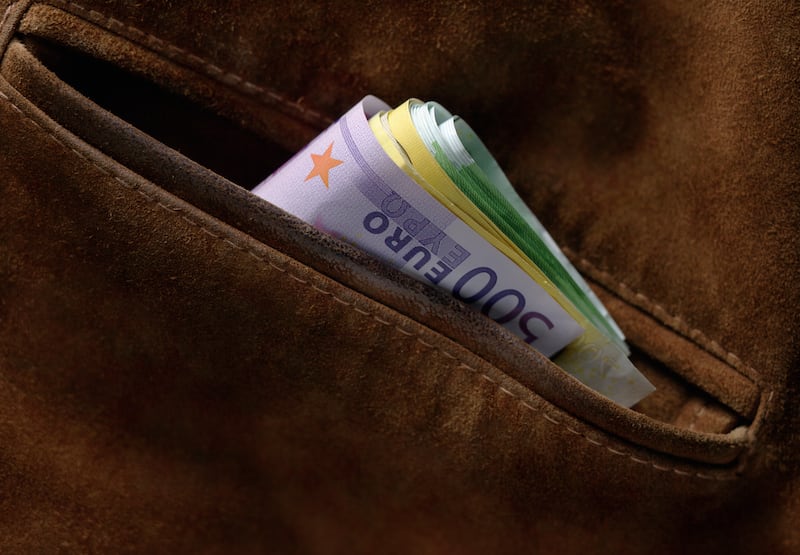Irish households are likely to benefit to the tune of less than €300 in tax cuts in this October’s budget. That’s right, families across the country are unlikely to feel significantly richer come next January when budget day measures kick in.
With just €800 million to play with on October 9th – and, of this, only about €200 million is available for tax cuts – some might wonder why bother with the pomp and circumstance of a budget day at all.

Indeed, while Government has an overall budgetary spend of €3.4 billion this year, some €2.6 billion has already been committed, which leaves about €800 million. But given the commitment under the programme for Government to have a minimum 2:1 ratio of investment versus tax cuts, this leaves just about €265 million available for tax cuts.
Of course, that’s to ignore the PR machinations that surround the annual pronouncement from the Minister for Finance – particularly important this year perhaps, with a potential general election in the offing.
So, while the budget might be tight this year – at least if the Government wants to stay within the confines of the so-called fiscal space – the budget “show” demands that the Minister pulls at least one little rabbit out of his hat.

As Daryl Hanberry, a tax partner with Deloitte, notes, "There are always nuanced things that can be done within the budget."
This could be done by introducing some revenue-raising measures which could help further tax cuts.
So, what might we expect?
Income taxes
The good news is there will be tax cuts on October 9th; the bad news is they most likely won’t be substantial.
"I don't think we're going to see anything radical in terms of either increasing, or decreasing, tax rates," says Keith Connaughton, tax partner with PwC, downplaying the potential risk of Mr Donohoe introducing a third rate of income tax, of 43 per cent, on incomes over €80,000, a move which could bring in €433 million in additional revenues.

“In reality, I don’t see him doing anything to rock the boat hugely,” he says. “It’ll be steady as she goes”.
Where there might be relief however is to the much discussed “squeezed middle”, with middle income earners likely to be the biggest winners on the tax relief front- even though the gains will be modest.
“All the indications are that there will be some widening of the bands which will pull people out of the higher tax rate into 20 per cent tax rate,” says Hanberry.
This means that we’re likely to see an increase in the standard rate band, which will allow middle income – and higher income – earners to pay tax at the standard rate on more of their earnings. At present, people pay tax at a rate of 20 per cent on earnings of up to €34,550, and 40 per cent above that.

Higher earners are unlikely to face a heavier tax burden.
If the Government doesn’t make a change, then 65,000 workers will find themselves pushed into the 40 per cent tax rate for the first time on the back of wage inflation.
So an increase in the band is seen as likely by tax experts, of the order of about €750-€1,000.
“It’s very rare to see it go up by more than €1,000,” says Hanberry.

An increase of €1,000, for example, would cost the exchequer €213 million (almost all the allocation for tax cuts) on a full-year basis, and would give someone back about €200 a year, or €4 a week.
But remember, the “real” savings will be limited.
“The reality is that wage inflation is likely to eat up that additional €750/€1,000,” says Connaughton.
Higher earners are unlikely to face a heavier tax burden.
“It would be detrimental to our international reputation if we were to further increase our marginal rate,” says Connaughton.
Hanberry agrees, noting we already have one of the most progressive tax systems in the developed world.
“It’s almost too progressive a tax system – a significant proportion of tax is paid by a small percentage of people who earn above about €70,000,” he says.
At the other end of the scale, some 941,600 income earners aren’t expected to pay income tax next year, but experts say it’s unlikely this will be broadened.

“I don’t think we’ll see measures to take huge a raft of people out of the tax net,” says Connaughton.

USC/PRSI
Experts say we might also see some small tweaking to the universal social charge (USC) rates.
“It’ll be nothing wild, it’ll be small changes,” says Connaughton.
This could see the Government adjust USC slightly to take more people out of the tax net. At present, people start paying USC at a rate of 2 per cent on incomes of more than €13,000, while a further cut in the 4.75 per cent rate may be a possibility. Last year it was cut back from 5 per cent.
“If they want to decrease the USC rates or increase the entry points, they will have to come up with revenue-generating measures,” says Connaughton.
The Government may give an insight into its plans for merging USC with PRSI on budget day, but it may come later.
“I’m not sure we’ll get that clarity given the complexity [of the merger],” says Hanberry.

Before this, an increase in PRSI could be on the way. The Department of Employment Affairs and Social Protection argued recently that PRSI should be increased to help pay for welfare benefits, as workers in Ireland pay one of the lowest rates of social insurance contributions in the OECD.
An increase in the rate of 4 per cent to 4.5 per cent, for example, would see someone earning €50,000 pay an additional €250 in PRSI a year, or someone earning €100,000 an additional €500 a year. It would bring in about €400 million for Government.
Self-employed
Given the number of discrepancies that exist between people paying tax in the PAYE system, and those who are self-employed and face a marginal tax rate of as much as 55 per cent, the Government has sought in recent years to align the two tax regimes.
One way it has done this has been through the introduction of the earned income credit, which was increased to €1,150 in last year’s budget.
However, as Connaughton notes, “this is still some way short of the PAYE credit of €1,650, so we may see something further there.”
There is certainly an expectation that the marginal rate should be below 50 per cent
This could see the Government narrow the gap by increasing the credit by around €250 to €1,400.

On the marginal tax rate side, however, the 3 per cent surcharge paid by the self-employed on incomes of €100,000, which brings their marginal rate to 55 per cent, “doesn’t look good internationally”, Hanberry says.
“There is certainly an expectation that the marginal rate should be below 50 per cent,” he says.
Inheritance tax
No change was made to Ireland’s inheritance tax regime last year, despite a commitment to bring the tax-free parent/child group threshold back up to about €500,000. It currently stands at €310,000 and, against a background of rising property prices, has been criticised as being too low.
However, Connaughton says it’s “more unlikely than likely that he’ll adjust the thresholds”, while Hanberry agrees that he’d be surprised if they moved it back to €500,000.
Indeed, tax revenue on inheritances has been growing strongly of late, and is forecast to bring in around €472 million for 2018, up from €237 million in 2010, so Government may be reluctant to change this.
It could, however, increase or decrease the small gift exemption, which currently stands at €3,000 a year.
CGT
With capital gains tax (CGT) at 33 per cent, Hanberry says there is “certainly a feeling that the rate of CGT is high”, adding that when the rate was cut to 20 per cent some years ago, the tax take almost doubled, which points to the potential for a cut in this rate.
Connaughton would also like to see Government consider increasing the threshold for entrepreneur relief. Currently at €1 million, it’s “significantly way off” the €10 million equivalent threshold in the UK.
Excise
An increase in excise on diesel is considered very likely. Earlier this year the ESRI concluded that such an increase would be justifiable on both fiscal and environmental grounds, and so we’re likely to see the duty on diesel brought into line with petrol. This could be a significant revenue-raiser, bringing in about €353 million a year.

Property tax
We know a change is coming, but we don’t know when – or how much it will be. Mr Donohoe has signalled that any changes to the current property tax regime won’t kick in until 2020, so a statement may not be made until after budget day.
But it will undoubtedly mean an increase in the tax burden for most homeowners, even if it will be, as indicated, “modest”.
With property valuations almost doubling in Dublin since 2012, and rising substantially elsewhere, the Government would face an extremely difficult task if it wanted everyone to re-value their houses based on current prices. For example, a house in the €300,000-€350,000 band in Dún Laoghaire Rathdown currently faces tax of €497 a year; if it was re-valued based on current prices, the tax would rocket to €956.
What might be expected, however, is an end to some of the exclusions that currently apply, such as all of those who bought their home in 2013.
Welfare payments
Those receiving welfare payments – and some 2.6 million Irish individuals and families receive a benefit of some sort – are likely to see some order of an increase this year. However, Minister for Social Protection Regina Doherty has already ruled out a €5 increase for everybody, as has been seen in recent budgets.
The Government could also look to improve welfare benefits for the self-employed, as it has pointed to in the past.

Landlords/housing
With the housing market one of the biggest issues facing the economy, tax experts say Mr Donohue might make a move to ease the tax burden on landlords.
“It would be a very unpopular move if he didn’t do anything,” says Connaughton.
One of the easiest options would be to increase mortgage interest which is allowable, up from 85 per cent at present, or to allow property tax as a deductible expense.
Other areas of potential focus include considering tax incentives to stimulate the rental market.












